Deployment Overview
This document describes how to set up multi-factor authentication (MFA) for Google Workspace with AuthPoint as an identity provider. Google Workspace must already be configured and deployed before you set up MFA with AuthPoint.
Google Workspace can be configured to support MFA in several modes. For this integration, we set up SAML with AuthPoint.
Single-sign on (SSO) is for web based Google applications. In some scenarios, users with super administrator privileges bypass single-sign on (SSO) when they sign in. For more information, see Signing in with SSO.
Google Workspace now supports multiple identity providers with single sign-on. For more information, see Introducing Google Cloud and Google Workspace support for multiple Identity providers with Single Sign-On.
For more information on how to configure SSO with third-party IdPs, see Set up SSO for Your Organization.
Google Workspace Authentication Data Flow with AuthPoint
AuthPoint communicates with various cloud-based services and service providers with the SAML protocol. This diagram shows the data flow of an MFA transaction for Google Workspace.
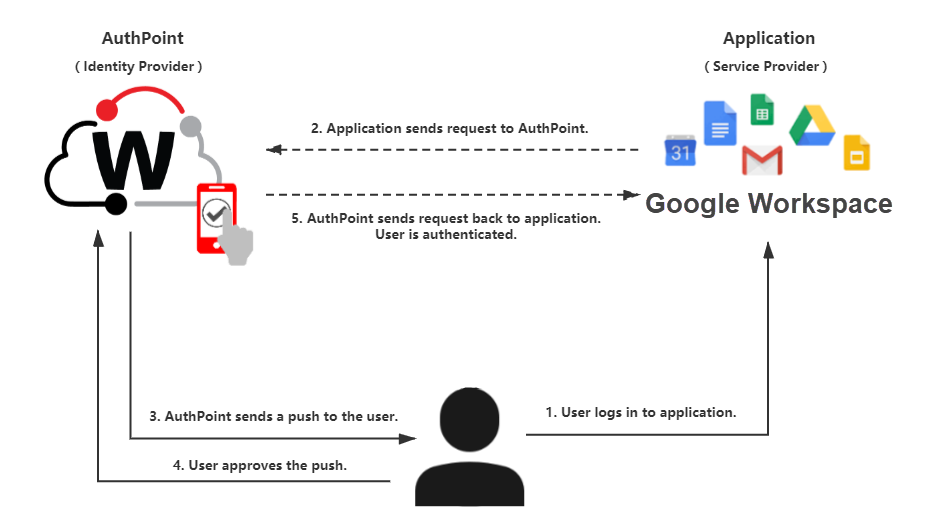
Before You Begin
Before you begin these procedures, make sure that:
- A Super Admin user can log in to the Google Workspace admin portal.
- A domain is created.
- A normal user is created under the domain in the Google Workspace admin portal.
- An AuthPoint user is created with an activated token in WatchGuard Cloud.
The email address for the user in AuthPoint must be the same as the email address for the user in Google Workspace. - You have an AuthPoint identity provider (IdP) certificate (go to Certificate Management).
Configure Google Workspace
To start, you must download the metadata file from the Certificate Management page in the AuthPoint management UI. After you have that, you can configure Google Workspace.
To configure Google Workspace:
- Log in to WatchGuard Cloud.
- From the navigation menu, select Configure > AuthPoint. If you have a Service Provider account, you must select an account from Account Manager.
- Select Resources.

- Click Certificate.
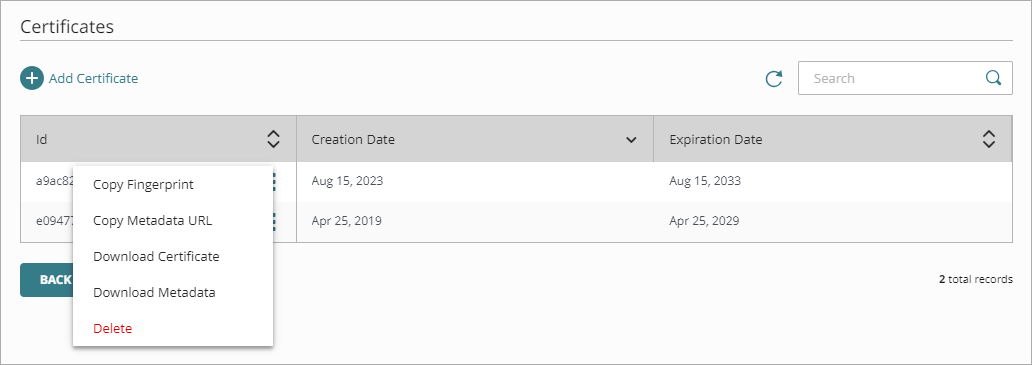
- Next to AuthPoint certificate that you want to associate with your resource, click
 and select Download Metadata and Download Certificate. We recommend that you choose the certificate with the latest expiration date. If you do not have a certificate, or if all of your certificates have expired, click Add Certificate and use the newly created certificate.
and select Download Metadata and Download Certificate. We recommend that you choose the certificate with the latest expiration date. If you do not have a certificate, or if all of your certificates have expired, click Add Certificate and use the newly created certificate.The AuthPoint metadata provides your resource, in this case Google Workspace, with information necessary to identify AuthPoint as a trusted identity provider.
Configure a Single IdP
In this status, all users sign in through a single IdP.
To configure a single IdP:
- Log in to the Google Admin Console for your account as an administrator.
- Select Security > Authentication > SSO with third party Idp.
- Select Third-party SSO profile for your organization.
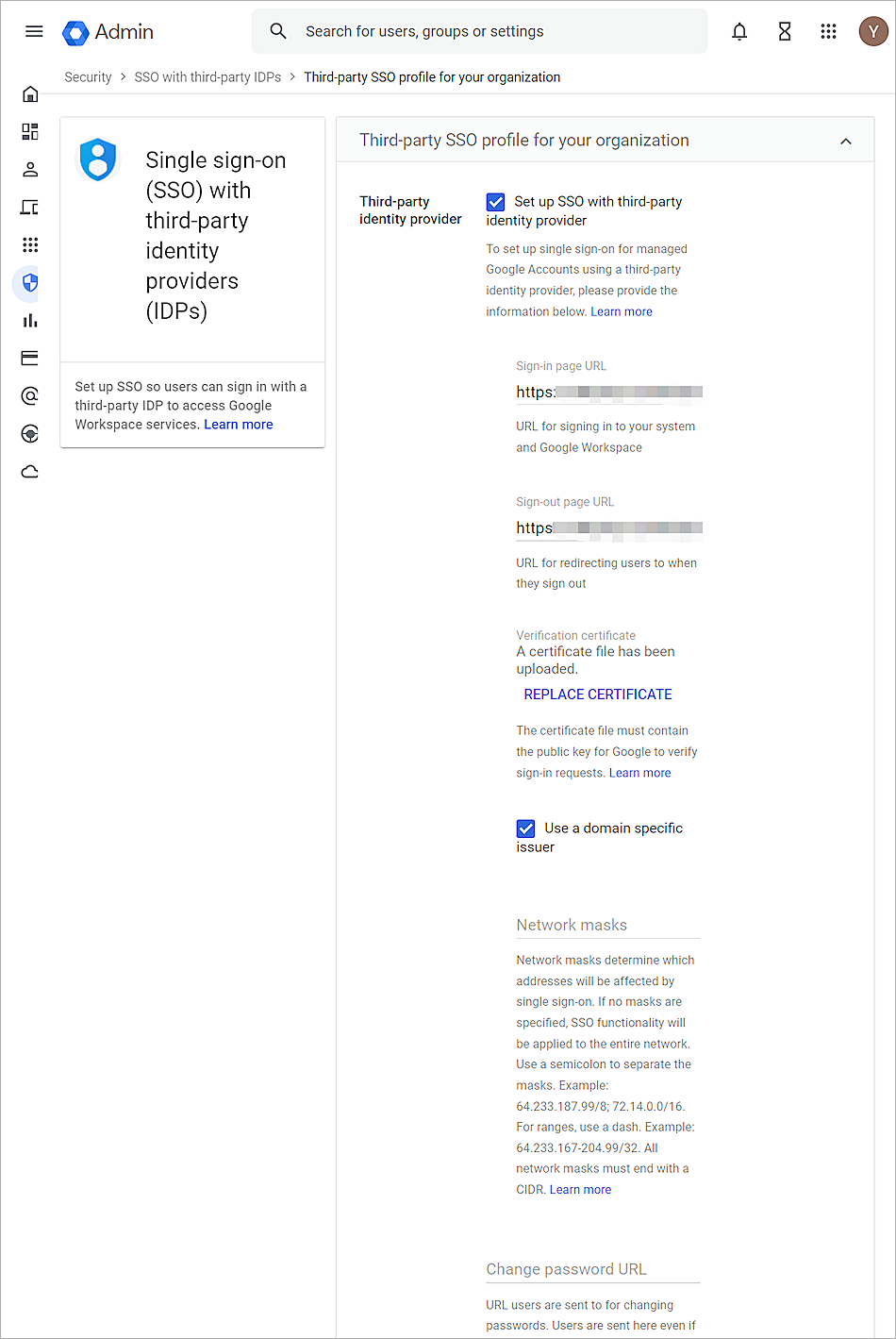
- Select the Set up SSO with third-party identity provider check box.
- Open the AuthPoint metadata file you downloaded and find the SingleSignOnService Location and SingleLogoutService Location values.
- In the Sign-in page URL text box, type or paste the SingleSignOnService Location value from the AuthPoint metadata file.
- In the Sign-out page URL text box, type or paste the SingleLogoutService Location value from the AuthPoint metadata file.
- Click Upload Certificate and browse to select the AuthPoint certificate file you downloaded.
- Select the Use a domain specific issuer check box.
- Leave other settings as the default values.
- Click Save.
Configure Multiple IdPs
In this status, different users can sign in with different IdPs.
To configure multiple IdPs:
- Log in to the Google Admin Console of your account as an administrator.
- Select Directory > Users.
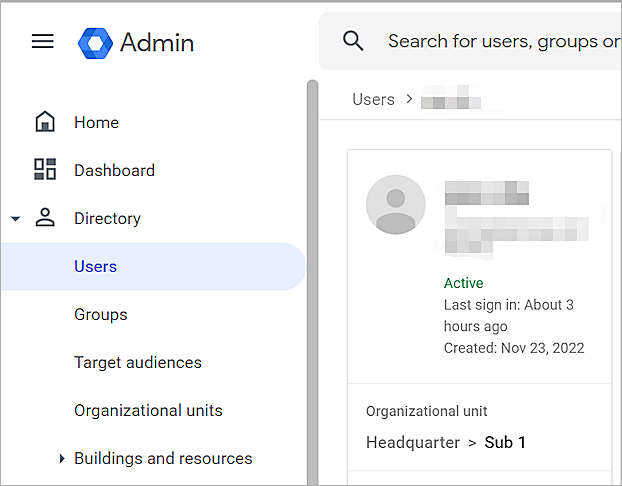
- Click your user and check the user organization. In this guide, the test user is under organization Sub 1.
- Select Security > Authentication > SSO with third party Idp.
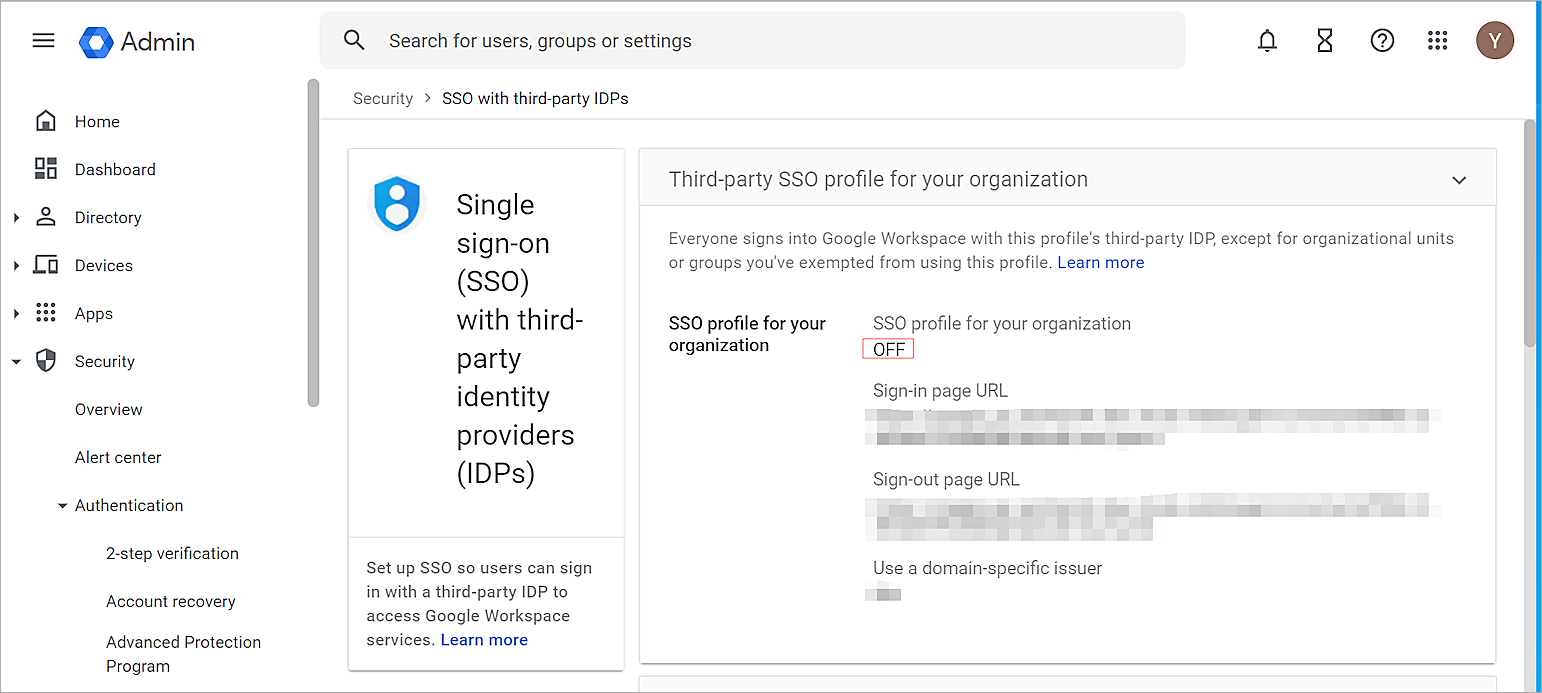
- In the Third-party SSO Profile for Your Organization section, verify that SSO profile for your organization is OFF.
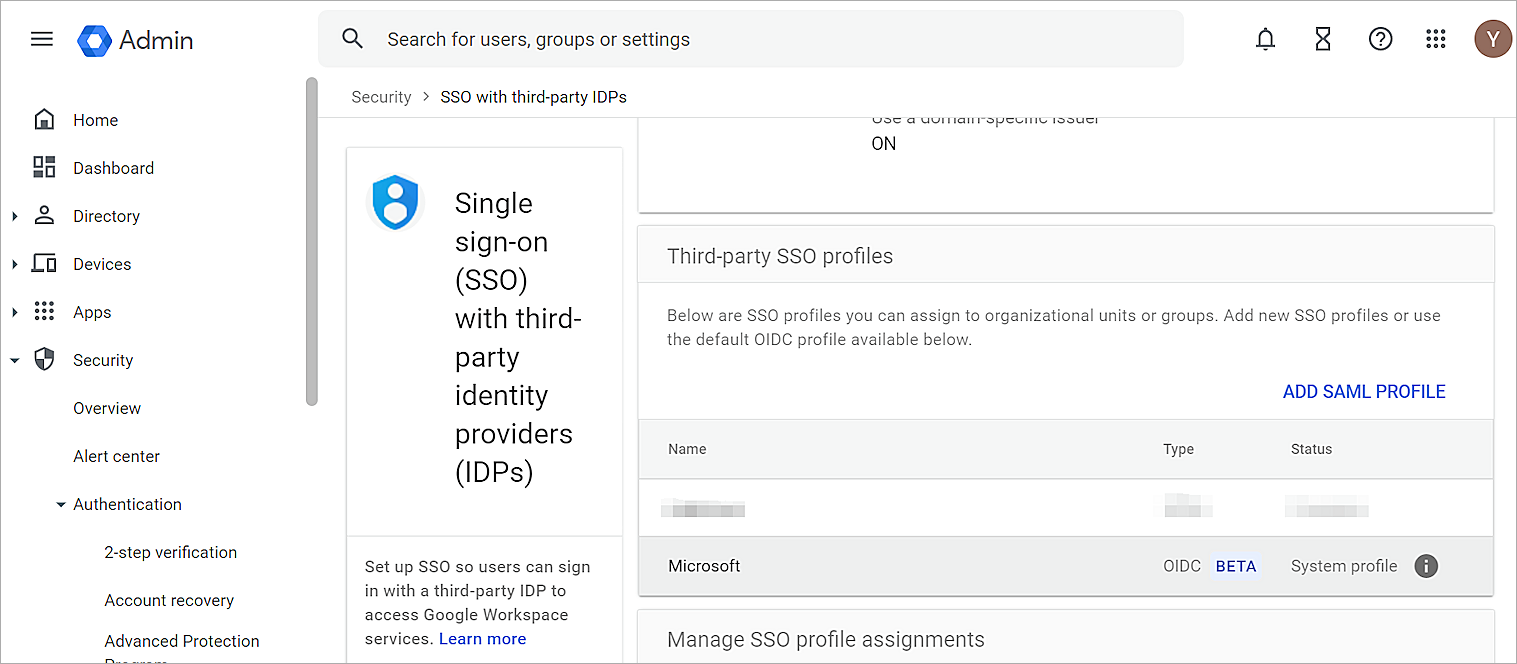
- In the Third-party SSO Profiles, click Add SAML Profile.
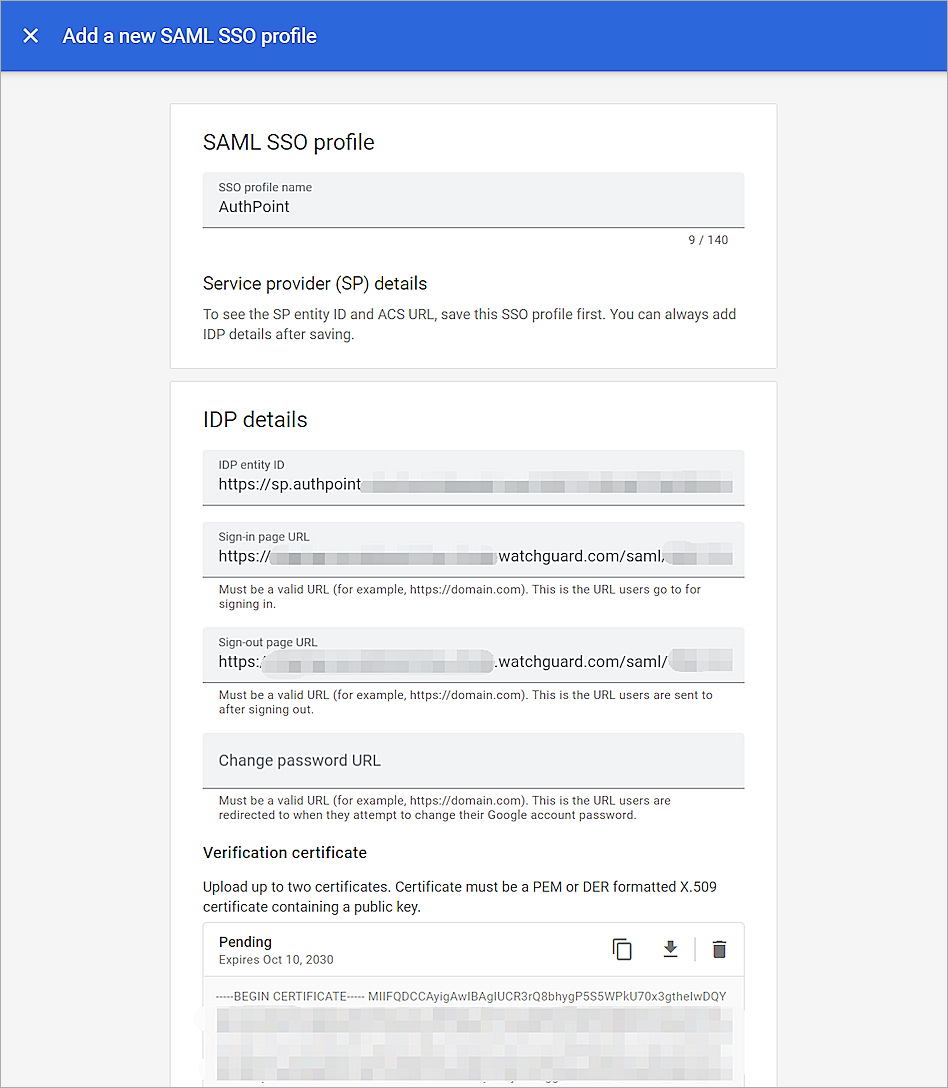
- In the SSO Profile Name text box, type a name. In this example, we type AuthPoint.
- Open the AuthPoint metadata file you downloaded and find the entityID, SingleSignOnService Location and SingleLogoutService Location values.
- In the IDP entity ID text box, type or paste the entityID value from the AuthPoint metadata file.
- In the Sign-in page URL text box, type or paste the SingleSignOnService Location value from the AuthPoint metadata file.
- In the Sign-out page URL text box, type or paste the SingleLogoutService Location value from the AuthPoint metadata file.
- Click Upload Certificate and browse to select the AuthPoint certificate file you downloaded.
- Leave other settings as the default values.
- Click Save.
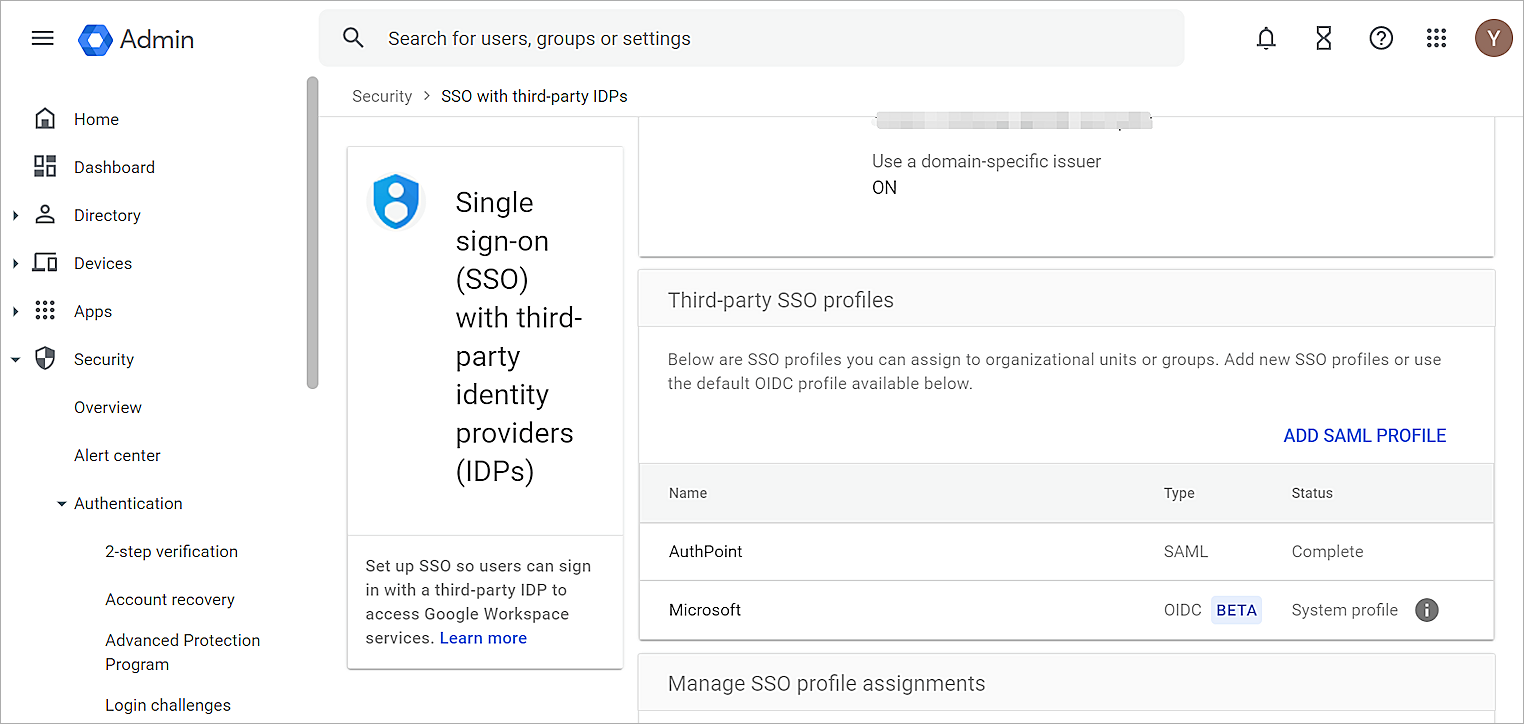
- Click the new profile AuthPoint.
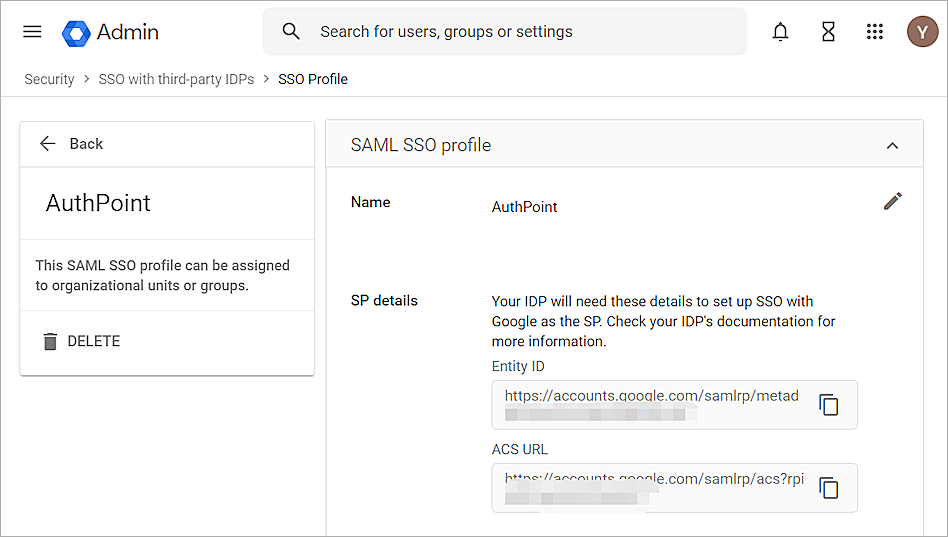
- Copy Entity ID and ACS URL values in SP details.
- Select Security > Authentication > SSO with third party Idp > Manage SSO profile assignments.
- Click Manage.
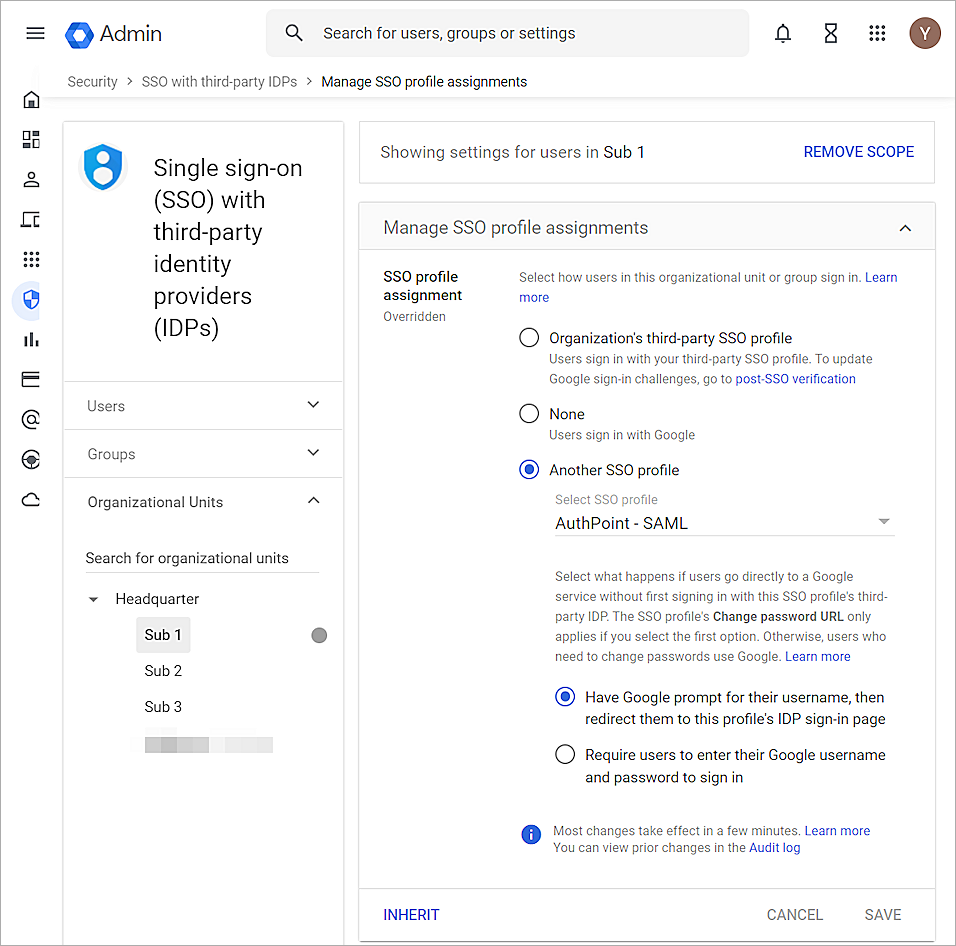
- Select test user organization. In this example, we select Sub 1.
- Click Another SSO profile.From the drop-down list, select the SSO profile created in before AuthPoint-SAML.
- Select Have Google prompt for their username, then redirect them to this profile's IDP sign-in page.
- Click Save.
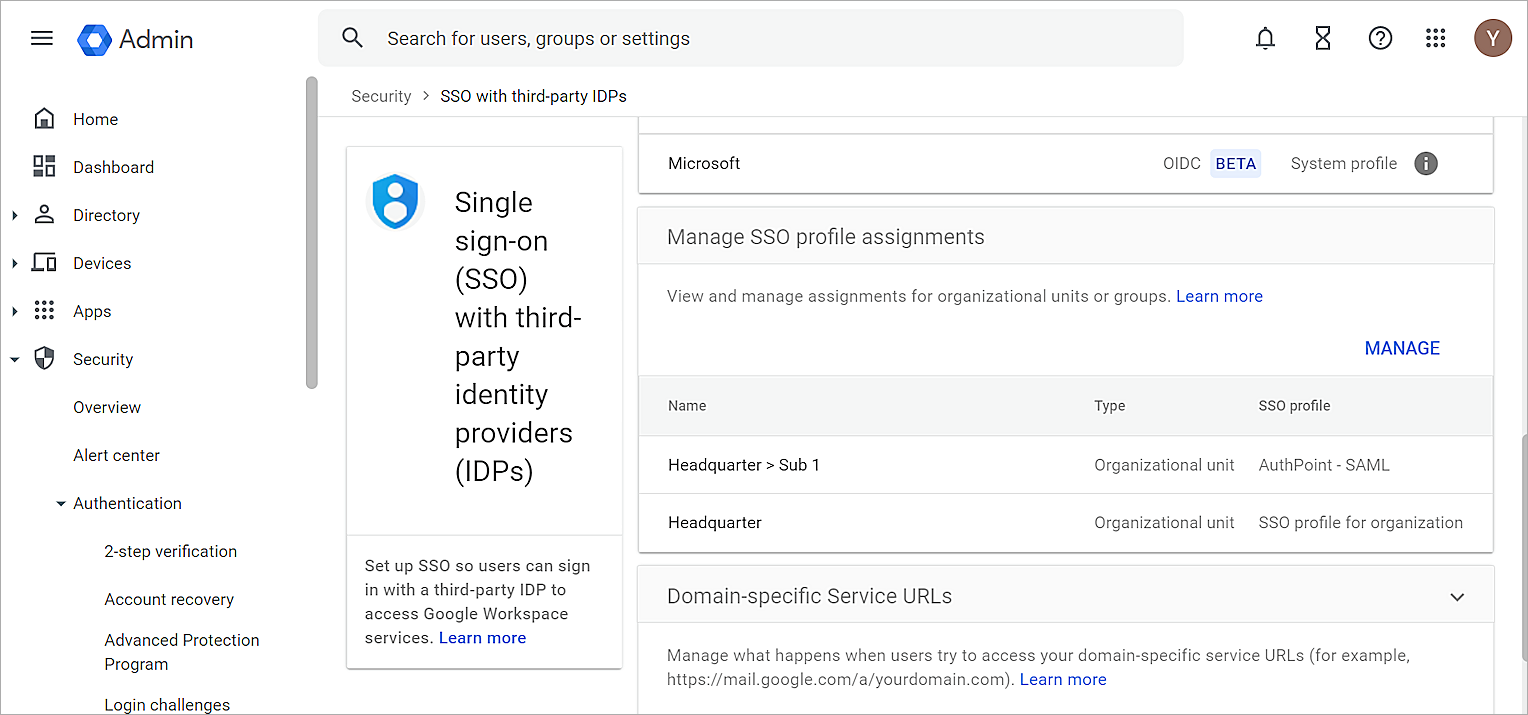
Configure AuthPoint
Before AuthPoint can receive authentication requests from Google Workspace, you must add a SAML resource in AuthPoint. You must also create an authentication policy for the Google Workspace resource to determine which users can authenticate and log in to Google Workspace and which authentication methods they can use (Push, QR code, and OTP).
Add a SAML Resource in AuthPoint
Configure a Single IdP
From the AuthPoint management UI:
- From the navigation menu, select Resources.
Click Add Resource.
The Add Resource page opens.

- From the Type drop-down list, select SAML.
Additional fields appear.

- In the Name text box, type a name for this resource.
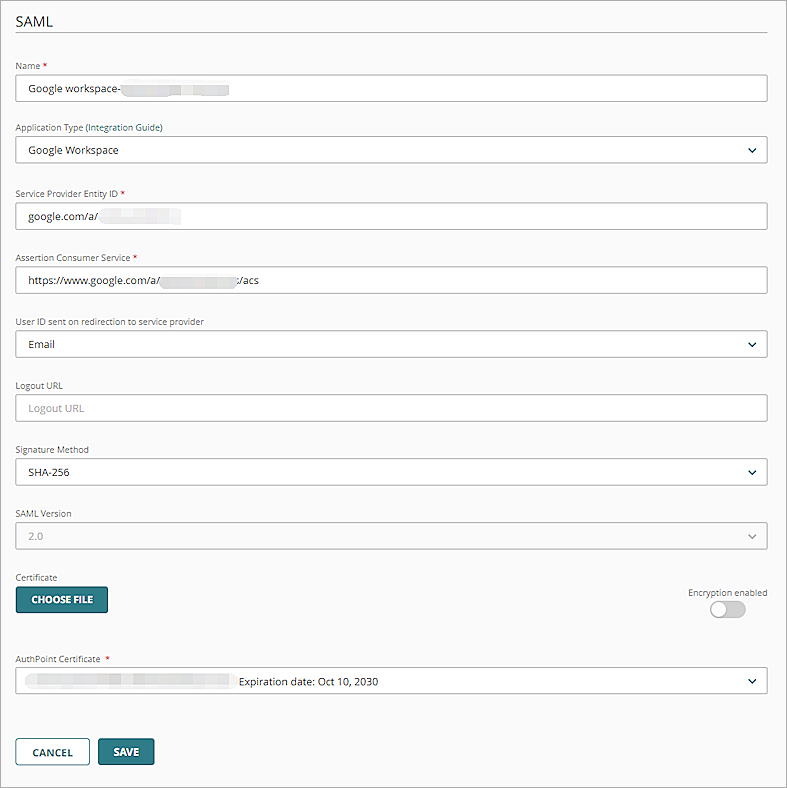
- From the Application Type drop-down list, select Google Workspace.
- In the Service Provider Entity ID text box, type google.com/a/<your domain>.
- In the Assertion Consumer Service text box, type https://www.google.com/a/<your domain>/acs.
- From the User ID Sent on Redirection to Service Provider drop-down list, select Email.
- From the Signature Method drop-down list, select SHA-256.
- From the AuthPoint Certificate drop-down list, select the certificate to associate with your resource. This must be the same certificate that you downloaded the metadata for in the previous section.
- Click Save.
Configure Multiple IdPs
From the AuthPoint management UI:
- From the navigation menu, select Resources.
Click Add Resource.
The Add Resource page opens.

- From the Type drop-down list, select SAML.
Additional fields appear.

- In the Name text box, type a name for this resource.
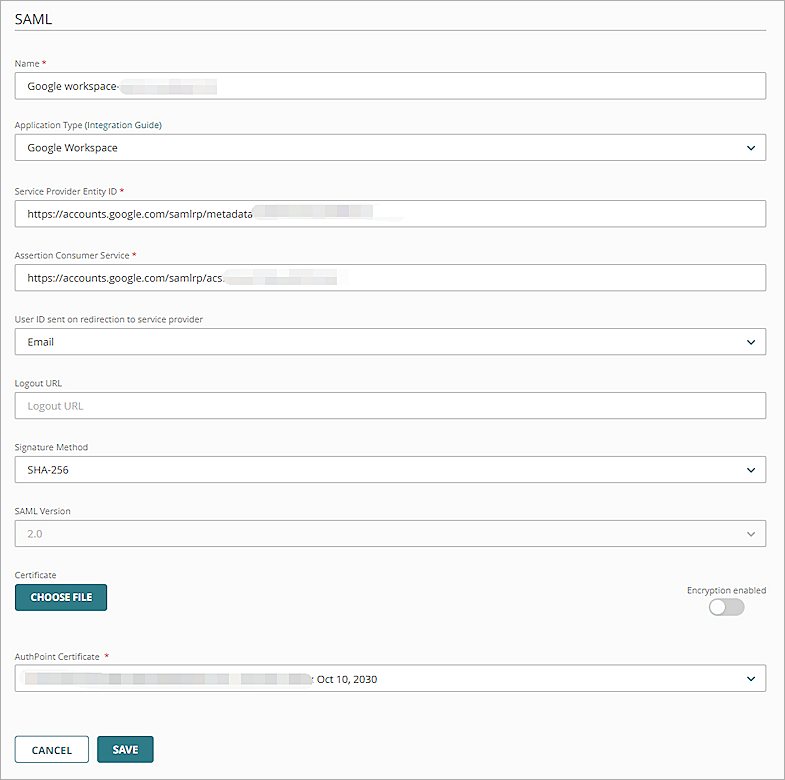
- From the Application Type drop-down list, select Google Workspace.
- In the Service Provider Entity ID text box, type Entity ID value get from Google workspace.
- In the Assertion Consumer Service text box, type ACS URL value get from Google workspace.
- From the User ID Sent on Redirection to Service Provider drop-down list, select Email.
- From the Signature Method drop-down list, select SHA-256.
- From the AuthPoint Certificate drop-down list, select the certificate to associate with your resource. This must be the same certificate that you downloaded the metadata for in the previous section.
- Click Save.
Add a Group in AuthPoint
You must have at least one user group in AuthPoint to configure MFA. If you already have a group, you do not have to add another group.
To add a group to AuthPoint:
- From the navigation menu, select Groups.
- Click Add Group.
The New Group page appears.

- In the Name text box, type a descriptive name for the group.
- (Optional) In the Description text box, type a description of the group.
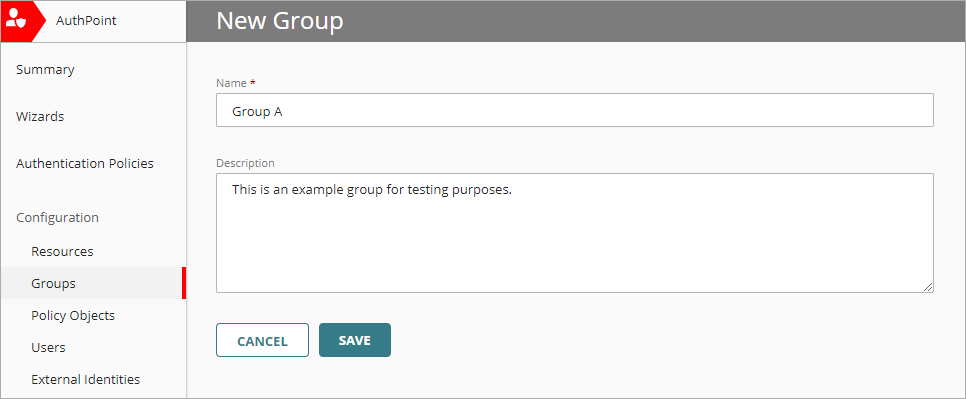
- Click Save.
Your group is listed on the Groups page.
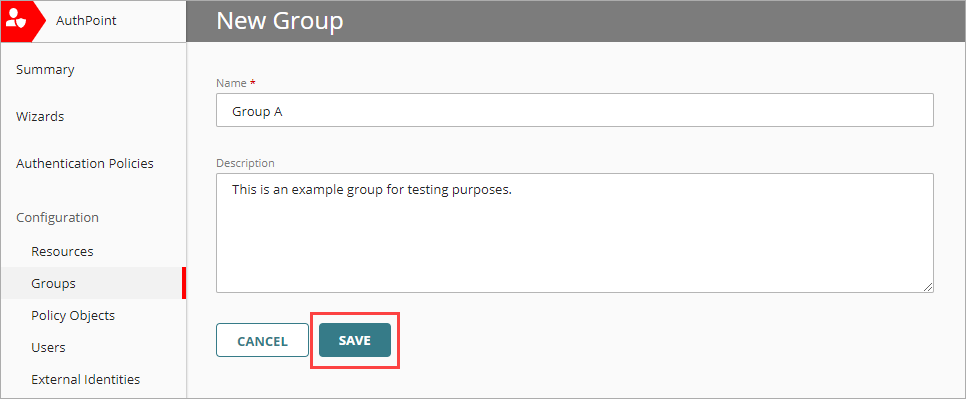
Add an Authentication Policy to AuthPoint
Authentication policies specify which resources users can authenticate to and which authentication methods they can use (Push, QR code, and OTP).
You must have at least one authentication policy in AuthPoint that includes the Google Workspace resource. If you already have authentication policies, you do not have to create a new authentication policy. You can add this resource to your existing authentication policies.
Users that do not have an authentication policy for a specific resource cannot authenticate to log in to that resource.
To configure an authentication policy:
- From the navigation menu, select Authentication Policies.
- Click Add Policy.

- Type a name for this policy.
- From the Select the authentication options drop-down list, select Authentication options and select which authentication options users can choose from when they authenticate.
For SAML resources, if you select more than one authentication option, users must select one of the available options when they authenticate. For example, if you select OTP and Push, users can choose to type their OTP or approve a push to authenticate. You cannot require that they do both.
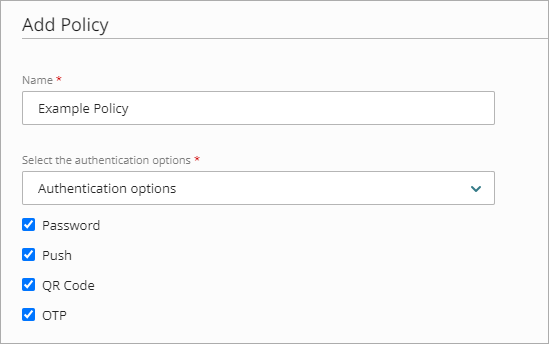
- Select which groups this policy applies to. You can select more than one group. To configure this policy to apply to all groups, select All Groups.
- Select the resource that you created in the previous section. If you want this policy to apply to additional resources, select each resource this policy applies to. To configure this policy to apply to all resources, select All Resources.

-
(Optional) If you have configured policy objects such as a Network Location, select which policy objects apply to this policy. When you add a policy object to a policy, the policy only applies to user authentications that are the same as the conditions of the policy objects. For example, if you add a Network Location to a policy, the policy only applies to user authentications that come from that Network Location. Users who only have a policy that includes a Network Location do not get access to the resource when they authenticate outside of that Network Location (because they do not have a policy that applies, not because authentication is denied).
If you configure policy objects, we recommend that you create a second policy for the same groups and resources without the policy objects. The policy with the policy objects should have a higher priority.

- Click Save.
Your policy is created and added to the end of the policy list.When you create a new policy, we recommend that you review the order of your policies. AuthPoint always adds new policies to the end of the policy list.
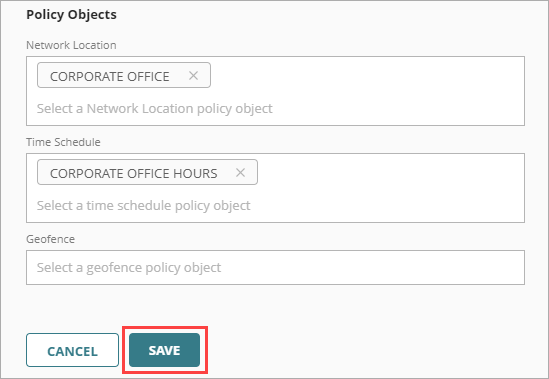
Add Users to AuthPoint
Before you assign users to a group, you must add the users to AuthPoint. There are two ways to add AuthPoint user accounts:
- Sync users from an external user database
- Add local AuthPoint users
Each user must be a member of a group. You must add at least one group before you can add users to AuthPoint.
To import users from Active Directory, Microsoft Entra ID, or an LDAP database, you must add an external identity in the AuthPoint management UI. External identities connect to user databases to get user account information and validate passwords.
- To sync users from Active Directory or an LDAP database, you must add an LDAP external identity
- To sync users from Microsoft Entra ID, you must add a Microsoft Entra ID external identity
When you sync users from an external user database, you can sync any number of users and they are all added to AuthPoint at one time. Users synced from an external user database use the password defined for their user account as their AuthPoint password.
To learn how to sync users, go to Sync Users from Active Directory or LDAP and Sync Users from Azure Active Directory.
You can create local AuthPoint users on the Users page in the AuthPoint management UI. Because you can create only one user at a time, you most commonly do this when you want to create test users or to add only a small number of users.
Unlike users synced from an external user database, local AuthPoint users define and manage their own AuthPoint password. When you add a local user account, the user receives an email that prompts them to set their password.
To learn how to add local AuthPoint user accounts, go to Add Local AuthPoint Users.
Test the Integration
To test AuthPoint MFA with Google Workspace, you can authenticate with a mobile token on your mobile device. You can choose any method (one-time password, QR code, or push).
In this example, we show the push authentication method (users receive a push notification in the mobile app that they must approve to authenticate).
To test the integration:
- In a web browser, go to accounts.google.com.
Single-sign on (SSO) is for web based Google applications. If you go to the admin console with a super admin account, you bypass SSO. For more information, see Signing in with SSO.
- In the Email or phone text box, type your user Gmail email address.
- Click Next.
- Type your email address or AuthPoint user name. Click Next.
Your AuthPoint user email address must be the same as your Gmail address. - If required, in the Password text box, type your password.
- For the authentication method, select Send Push.
- Approve the authentication request that is sent to your mobile device.
You are logged in to your Google Workspace account.